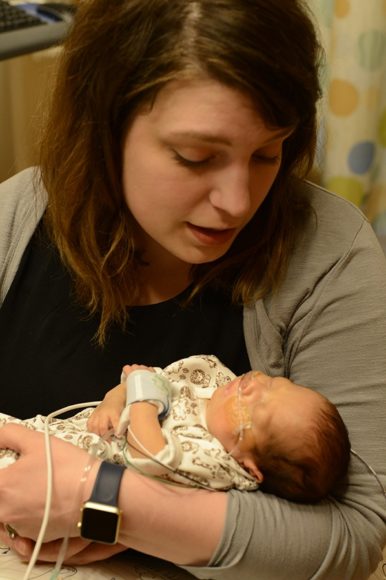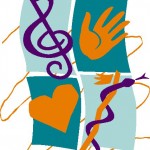NICU Music Therapy in Wisconsin & Beyond
July 1, 2018
By Melissa Cole, MT-BC, WMTR
Member of the Wisconsin Chapter for Music Therapy

Melissa Neitzel, MT-BC
- In 2016 American Academy of Pediatrics (AAP) published “Music Therapy for Preterm Infants and Their Parents: A Meta-analysis”. The research included 964 infants and 266 parents with the conclusion stating “There is sufficient evidence to confirm a large, favorable effect of MT on infant respiratory rate and maternal anxiety. More rigorous research on short-term and long-term infant and parent outcomes is required.”
- In 2013 the AAP published “The Effects of Music Therapy on Vital Signs, Feeding, and Sleep in Premature Infants” in which the primary investigator concluded that “the informed, intentional therapeutic use of live sound and parent-preferred lullabies applied by a certified music therapist can influence cardiac and respiratory function. Entrained with a premature infant’s observed vital signs, sound and lullaby may improve feeding behaviors and sucking patterns and may increase prolonged periods of quiet–alert states.”
- In 2008 the AAP’s magazine article “Medical Music Therapy” showed support of music therapy in the NICU and with broader populations.
In June of 2018 Melissa Neitzel, MT-BC was featured in a story called “Finding Solace Through Song” and shared her story of developing a music therapy program in the neonatal intensive care unit (NICU) at Children’s Hospital of Wisconsin. But she was not the first MT-BC in the NICU to make the news in Wisconsin. In 2015 Carolann Franke, MT-BC of Music Therapy Services of Central Wisconsin, LLC was featured in a story called “How Music Therapy Shortens NICU Stays“, at Marshfield Children’s – Marshfield Medical Center (formally St. Joseph’s Hospital).
The Wisconsin professionals in both stories are Music Therapists – Board Certified (MT-BC), meaning they have completed a minimum of a Bachelor’s degree in Music Therapy, 300 hours of practicums and 900-hour internship, and passing a Board Certification examination. Music Therapists from both companies in the stories are on the NICU-MT Registry , assuring they have completed a 30-hour specialized training course that includes lecture, clinical fieldwork and reading. The National Institute for Infant & Child Medical Music Therapy grant the NICU-MT designation and states that “Premature infants are extremely fragile with many beginning their treatment at a basic survival level. Handling and interaction can be harmful to their care and must be carefully designed…especially when adding non-essential stimuli such as music. Evidence-based music therapy treatment in this most critical setting is based on information about the needs of the infants, medical and developmental goals of NICU care, and music therapy protocols documented in refereed research literature.”
According to Neitzel, “When infants are born so early, they miss out on a critical time for development. Any sense of overstimulation releases stress, which hurts their neural development. Their brains basically pause. Music therapy helps increase their tolerance to sound, decreasing those stressful moments so they continue to develop and get home sooner. We use the Multimodal Neurological Enhancement (MNE) protocol, which helps infants tolerate and process different stimulation. The intervention starts with humming because that’s the least stimulating.”
Both Wisconsin stories share themes of shortening the length of hospital stay with music therapy, and providing emotional support for families. Biomedical music therapy in the NICU, with physiological stability as the primary objective, has been well documented with positive results. These include decreased number of days in NICU by 11-12 days, weight gain, stabilized oxygen saturation levels, and pacification. These quality medical benchmarks of developmental outcomes for infants also reduce medical costs. Other applications of music therapy in the NICU have been explored as of late. In 2013 music therapy for preterm infants was looked at specifically during stressful procedural events, such as endotracheal suctioning. Creative music therapy, applications based on attachment theory (lifespan emotional connections start with parent-infant bond) and neurobehavioral development are all areas recently studied with music therapy in the NICU.
In hospitals where music therapy is not available, other NICU staff can play an important role in optimizing neurodevelopment in premature infants with guidelines found in this article Music in the NICU: The Role of Nurses in Neuroprotection. While 30 years ago medical staff resisted the idea that music therapy could impact premature infant medical outcomes, a 2006 study of 187 NICU staff tells a different story. Staff attitudes and expectations reported favorable to music for patients and were not a barrier to music therapy in the NICU. This holds true in Wisconsin, also. Music Therapy Services of Central Wisconsin, LLC has provided Music Therapy at the NICU in Marshfield Children’s – Marshfield Medical Center (formally St. Joseph’s Hospital), Wisconsin for the past 9 years. Owner Richelle Kroening, MT-BC states “The music therapy program is very strong and supported by the neonatologists, nurses, occupational/speech therapy and other staff on the treatment team. We have daily quiet times, where all procedures stop, lights are dimmed, and minimal staff are present. We assist families in making a special song and/or recordings for their infants (we have many parents that live far away from the hospital and can’t visit as often as they would like), provide teaching on how to watch for infants’ cues and how to use singing and touch safely with their baby.”
Bibliography
Allen, K. A. (2013). Music Therapy in the NICU: Is there Evidence to support Integration for Procedural Support? Advances in Neonatal Care : Official Journal of the National Association of Neonatal Nurses, 13(5), 10.1097/ANC.0b013e3182a0278b. http://doi.org/10.1097/ANC.0b013e3182a0278b
Bouhairie A, Kemper KJ, Martin K, Woods C. (2006) Staff attitudes and expectations about music therapy: pediatric oncology versus neonatal intensive care unit. J Soc Integr Oncol.;4(2) 71-74. PMID: 19442339.
Detmer, M., Whelan, M., (2017) Music in the NICU: The Role of Nurses in Neuroprotection. Neonatal Network Vol 36 Issue 4, DOI: 10.1891/0730-0832.36.4.213
Edwards, J. (2011). The use of music therapy to promote attachment between parents and infants. The Arts in Psychotherapy, ISSN: 0197-4556, Vol: 38, Issue: 3, Page: 190-195. DOI: 10.1016/j.aip.2011.05.002
Friederike Barbara Haslbeck (2014) Creative music therapy with premature infants: An analysis of video footage. Nordic Journal of Music Therapy, 23:1, 5:35, DOI: 10.1080/08098131.2013.780091
Gooding, L. (2010). Using music therapy protocols in the treatment of premature infants: An introduction to current practices. The Arts in Psychotherapy, ISSN: 0197-4556, Vol: 37, Issue: 3, Page: 211-214. DOI: 10.1016/j.aip.2010.04.003
Loewy, J., Stewart, K., Dassler, A., Telsey, A., Homel, P. (2013) The Effects of Music Therapy on Vital Signs, Feeding, and Sleep in Premature Infants. Pediatrics 131 (5) 902-918; DOI: 10.1542/peds.2012-1367
Łucja B., Claire G., Christian G. (2016) Music Therapy for Preterm Infants and Their Parents: A Meta-analysis. Pediatrics, 138 (3) e20160971; DOI: 10.1542/peds.2016-0971
Malloch, S. Shoemark H., Črnčec R. Newnham, C., Campbell, P., Prior M., Coward S., Burnham D., (2012) Music therapy with hospitalized infants—the art and science of communicative musicality. Infant Mental Health Journal, ISSN: 0163-9641, Vol: 33, Issue: 4 Page: 386-399. DOI:10.1002/imhj.21346. https://doi.org/10.1002/imhj.21346
Shoemark H., Hanson-Abromeit D., Stewart L. (2015). Constructing optimal experience for the hospitalized newborn through neuro-based music therapy. Frontiers in Human Neuroscience Vol 9 pg 487. DOI: 10.3389/fnhum.2015.00487. https://www.frontiersin.org/article/10.3389/fnhum.2015.00487



